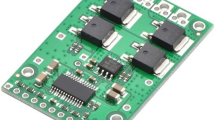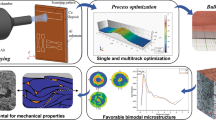Abstract
This study aims to establish a general-purpose thermal conductivity measurement method that can take into account the effect of heat loss under atmospheric conditions for measuring the effective thermal conductivity of lattice structures, and to clarify the effective thermal conductivity of lattice structures with different wire diameters. In this paper, calculations by finite element method and measurements using steady state comparative-longitudinal heat flow method and modified temperature profile method were performed to clarify the effective thermal conductivity of the five truncated octahedron unit-cell lattice structures with different wire diameters fabricated by additive manufacturing. The modified temperature profile method is developed to take into account the effect of interfacial thermal resistance in the measurement apparatus. The effective thermal conductivity measured using the steady state comparative-longitudinal heat flow method and calculated with finite element method analysis showed good agreement, confirming that the effective thermal conductivity is strongly dependent on the wire diameter. The effective thermal conductivity obtained by the modified temperature profile (MTP) method was 3 % to 24 % smaller than that obtained by the steady state comparative-longitudinal heat flow method, and the measurement was able to take heat loss into account more concretely. Furthermore, measurements using the MTP method enabled us to obtain reasonable values for the ratio of heat loss in each section, the fin efficiency of the sample, the heat transfer coefficient to the surroundings, and the interfacial thermal resistance between the rods and the sample.














Similar content being viewed by others
Data Availability
The datasets generated during and analyzed during the current study are available from the corresponding author on reasonable request.
Abbreviations
- \(Q_{R}\) :
-
Amount of heat flow of rod (W)
- \(k_{R}\) :
-
Thermal conductivity of rod (W⋅m−1⋅K−1)
- \(A_{R}\) :
-
Cross-sectional area of rod (m2)
- \(Q_{UR}\) :
-
Amount of heat flow of upper rod (W)
- \(Q_{LR}\) :
-
Amount of heat flow of lower rod (W)
- \(k_{eff}\) :
-
Effective thermal conductivity of sample for conventional method (W⋅m−1⋅K−1)
- \(A_{S}\) :
-
Cross-sectional area of sample (m2)
- \(Q_{C}\) :
-
Amount of heat flow through interface (W)
- \(A_{g}\) :
-
Contact area of the interface (m2)
- \(k_{exp}\) :
-
Effective thermal conductivity of sample for MTP method (W⋅m−1⋅K−1)
- \(T_{UC}\) :
-
Temperature difference of upper cartridge block from the surroundings (K)
- \(T_{LC}\) :
-
Temperature difference of lower cartridge block from the surroundings (K)
- \(Q_{SLOS}\) :
-
Heat loss from sample to the surroundings (W)
- \(Q_{ULOS}\) :
-
Heat loss from the rod and cartridge blocks at the upper side of the sample to the surroundings (W)
- \(Q_{LLOS}\) :
-
Heat loss from the rod and cartridge blocks at the lower side of the sample to the surroundings (W)
- \(S_{S}\) :
-
Surface area of the sample (m2)
- \(S_{R}\) :
-
Surface area of the rod (m2)
- \(S_{C}\) :
-
Surface area of the cartridge block (m2)
- \(h\) :
-
Heat transfer coefficient giving the heat loss to the surroundings (W⋅m−2⋅K−1)
- \(\phi\) :
-
Fin efficiency (–)
- \(T_{US}\) :
-
Temperature difference of upper surface of the sample from the surroundings (K)
- \(T_{LS}\) :
-
Temperature difference of lower surface of the sample from the surroundings (K)
- \(Q_{LOS}\) :
-
Total heat loss to the surroundings (W)
- \(R_{C}\) :
-
Interfacial thermal resistance of upper and lower interface of sample in case of assuming the interfacial thermal resistance of the upper and lower interface is the same for MTP method (km2⋅W−1)
- \(Q_{UC}\) :
-
Amount of heat flow into sample (W)
- \(Q_{LC}\) :
-
Amount of heat flow out of sample (W)
- \(t_{C}\) :
-
Thickness of cartridge block (m)
- \(k_{C}\) :
-
Thermal conductivity of cartridge block (W⋅m−1⋅K−1)
- \(A_{C}\) :
-
Cross-sectional area of cartridge block (m2)
- \(T_{x}\) :
-
Temperature rise profile in the direction of heat flow in the sample (K)
- \(L_{S}\) :
-
Thickness of sample (m)
- \(x\) :
-
Axial position on sample (m)
- \(m^{ - 1}\) :
-
Thermal healing length (m)
- \(P_{S}\) :
-
Perimeter of sample (m)
- \(R^{2}\) :
-
Coefficient of determination (–)
- \(T_{s1}\) :
-
Temperature raise of the measurement point closest to the upper rod at the sample (K)
- \(T_{s3}\) :
-
Temperature raise of the measurement point closest to the lower rod at the sample (K)
- \(x_{s1}\) :
-
Position of the measurement point closest to the upper rod at the sample (m)
- \(x_{s3}\) :
-
Position of the measurement point closest to the lower rod at the sample (m)
- \(R_{U}\) :
-
Interfacial thermal resistance between upper rod and sample in case of assuming the interfacial thermal resistance of the upper and lower interface is different for MTP method (m2⋅K−1⋅W−1)
- \(R_{L}\) :
-
Interfacial thermal resistance between sample and lower rod in case of assuming the interfacial thermal resistance of the upper and lower interface is different for MTP method (m2⋅K−1⋅W−1)
References
M.E. Korkmaz, M.K. Gupta, G. Robak, K. Moj, G.M. Krolczyk, M. Kuntoğlu, Development of lattice structure with selective laser melting process: a state of the art on properties, future trends and challenges. J. Manuf. Process. 81, 1040–1063 (2022)
B.K. Nagesha, V. Dhinakaran, M. Varsha Shree, K.P. Manoj Kumar, D. Chalawadi, T. Sathish, Review on characterization and impacts of the lattice structure in additive manufacturing. Mater. Today Proc. 21, 916–919 (2020)
L.-Y. Chen, S.-X. Liang, Y. Liu, L.-C. Zhang, Additive manufacturing of metallic lattice structures: unconstrained design, accurate fabrication, fascinated performances, and challenges. Mater. Sci. Eng. R Rep. 146, 100648 (2021)
N. Lebaal, Y. Zhang, F. Demoly, S. Roth, S. Gomes, A. Bernard, Optimised lattice structure configuration for additive manufacturing. CIRP Ann. 68(1), 117–120 (2019)
L. Zhang, B. Song, J.J. Fu, S.S. Wei, L. Yang, C.Z. Yan, H. Li, L. Gao, Y.S. Shi, Topology-optimized lattice structures with simultaneously high stiffness and light weight fabricated by selective laser melting: design, manufacturing and characterization. J. Manuf. Process. 56, 1166–1177 (2020)
K. Kitazono, R. Tada, Y. Sugiyama, T. Miura, Effects of cell morphology and heat treatment on impact energy absorption property of porous aluminum used for landing gears of a small satellite. Aerosp. Technol. Jpn. 17, 115–119 (2018)
V. Acanfora, S. Saputo, A. Russo, A. Riccio, A feasibility study on additive manufactured hybrid metal/composite shock absorbers. Compos. Struct. 268, 113958 (2021)
X.Z. Zhang, M. Leary, H.P. Tang, T. Song, M. Qian, Selective electron beam manufactured Ti–6Al–4V lattice structures for orthopedic implant applications: current status and outstanding challenges. Curr. Opin. Solid State Mater. Sci. 22(3), 75–99 (2018)
Y. Koizumi, A. Okazaki, A. Chiba, T. Kato, A. Takezawa, Cellular lattices of biomedical Co–Cr–Mo-alloy fabricated by electron beam melting with the aid of shape optimization. Addit. Manuf. 12, 305–313 (2016)
R. Hatakenaka, T. Kinjo, M. Saitoh, H. Sugita, T. Yamamoto, Heat-transfer characteristics of a lightweight, fin-integrated PCM Unit manufactured by additive manufacturing. in Proceeding of 47th International Conference on Environmental Systems (2017). http://hdl.handle.net/2346/73104
Y. Guo, H. Yang, G. Lin, H. Jin, X. Shen, J. He, J. Miao, Thermal performance of a 3D printed lattice-structure heat sink packaging phase change material. Chin. J. Aeronaut. 34(5), 373–385 (2021)
J.Y. Ho, K.C. Leong, T.N. Wong, Experimental and numerical investigation of forced convection heat transfer in porous lattice structures produced by selective laser melting. Int. J. Therm. Sci. 137, 276–287 (2019)
M. Khalil, M.I.H. Ali, K.A. Khan, R.A. Al-Rub, Forced convection heat transfer in heat sinks with topologies based on triply periodic minimal surfaces. Case Stud. Therm. Eng. 38, 102313 (2022)
T. Dixit, E. Al-Hajri, M.C. Paul, P. Nithiarasu, S. Kumar, High performance, microarchitected, compact heat exchanger enabled by 3D printing. Appl. Therm. Eng. 210, 118339 (2022)
A. Takezawa, X. Zhang, M. Kato, M. Kitamura, Method to optimize an additively-manufactured functionally-graded lattice structure for effective liquid cooling. Addit. Manuf. 28, 285–298 (2019)
S. Catchpole-Smith, R.R.J. Sélo, A.W. Davis, I.A. Ashcroft, C.J. Tuck, A. Clare, Thermal conductivity of TPMS lattice structures manufactured via laser powder bed fusion. Addit. Manuf. 30, 100846 (2019)
D. Muñoz Codorníu, J.J. Moyano, M. Belmonte, M.I. Osendi, P. Miranzo, Thermal conduction in three-dimensional printed porous samples by high resolution infrared thermography. Open Ceram. 4, 100028 (2020)
R.R. Sélo, S. Catchpole-Smith, I. Maskery, I. Ashcroft, C. Tuck, On the thermal conductivity of AlSi10Mg and lattice structures made by laser powder bed fusion. Addit. Manuf. 34, 101214 (2020)
J.-H. You, K. Park, Design and additive manufacturing of thermal metamaterial with high thermal resistance and cooling capability. Addit. Manuf. 41, 101947 (2021)
T. Ogushi, N. Iwamoto, Steady state longitudinal thermal conductivity measurement method of a thick specimen with low thermal conductivity MTP Method. J. Jpn. Inst. Electron. Packag. 21(2), 108–113 (2018)
EOS GmbH—Electro Optical Systems, Material Data Sheet EOS Aluminium AlSi10Mg (2011). http://www.hvd.co.jp/assets/img/service/3d-printer/Aluminum.pdf
Japanese Standards Association, JIS H 7903 (2008)
H.S. Carslaw, J.C. Jaeger, Conduction of Heat in Solids, 2nd edn. (Oxford University Press, Oxford, 1959), p.139
J.E. Graebner, K. Azar, Thermal conductivity measurements in printed wiring boards. J. Heat Transfer 119, 401–405 (1997)
Japan Society of Thermophysical Properties, Thermophysical Properties Handbook (2008), p. 213
T. Ogushi, S. Yanaura, S. Watanabe, T. Hirata, Thermal conductivity measurement method for isotropic conductive adhesives. Netsu Bussei 28(1), 22–28 (2014)
Author information
Authors and Affiliations
Contributions
RU: Conceptualization, Methodology, Investigation, Formal analysis, preparing figures, Writing—Original Draft. AU: Investigation, Resources, Writing—Review & Editing. HN: Conceptualization, Resources, Writing—Review & Editing, Funding acquisition. MO: Preparing test specimens, Review & Editing. TO: Conceptualization, Methodology, Supervision, Review & Editing.
Corresponding author
Ethics declarations
Conflict of interest
The authors declare that they have no known competing financial interests or personal relationships that could have appeared to influence the work reported in this article.
Additional information
Publisher's Note
Springer Nature remains neutral with regard to jurisdictional claims in published maps and institutional affiliations.
Rights and permissions
Springer Nature or its licensor (e.g. a society or other partner) holds exclusive rights to this article under a publishing agreement with the author(s) or other rightsholder(s); author self-archiving of the accepted manuscript version of this article is solely governed by the terms of such publishing agreement and applicable law.
About this article
Cite this article
Umemoto, R., Ueno, A., Nagano, H. et al. Effective Thermal Conductivity Measurement of Additively Manufactured Lattice Structures by Application of Modified Temperature Profile Method. Int J Thermophys 44, 95 (2023). https://doi.org/10.1007/s10765-023-03206-1
Received:
Accepted:
Published:
DOI: https://doi.org/10.1007/s10765-023-03206-1




